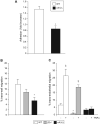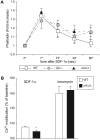Unique and redundant roles of alpha4 and beta2 integrins in kinetics of recruitment of lymphoid vs myeloid cell subsets to the inflamed peritoneum revealed by studies of genetically deficient mice
- PMID: 17553614
- PMCID: PMC2023970
- DOI: 10.1016/j.exphem.2007.04.015
Unique and redundant roles of alpha4 and beta2 integrins in kinetics of recruitment of lymphoid vs myeloid cell subsets to the inflamed peritoneum revealed by studies of genetically deficient mice
Abstract
Objective: Leukocyte recruitment to inflammatory sites is a prominent feature of acute and chronic inflammation. Instrumental in this process is the coordinated upregulation of leukocyte integrins (among which alpha4beta1 and beta2 integrins are major players) and their cognate receptors in inflamed tissues. To avoid the ambiguity of previous short-term antibody-based studies and to allow for long-term observation, we used genetically deficient mice to compare roles of alpha4 and beta2 integrins in leukocyte trafficking.
Materials and methods: Aseptic peritonitis was induced in alpha4 or beta2 integrin-deficient (conditional and conventional knockouts, respectively) and control mice, and recruitment of major leukocyte subsets to the inflamed peritoneum was followed for up to 4 days.
Results: Despite normal chemokine levels in the peritoneum and adequate numbers, optimal recruitment of myeloid cells was impaired in both alpha4- and beta2-deficient mice. Furthermore, clearance of recruited neutrophils and macrophages was delayed in these mice. Lymphocyte migration to the peritoneum in the absence of alpha4 integrins was drastically decreased, both at steady state and during inflammation, a finding consistent with impaired lymphocyte in vitro adhesion and signaling. By contrast, in the absence of beta2 integrins, defects in lymphocyte recruitment were only evident when peritonitis was established.
Conclusions: Our data with concurrent use of genetic models of integrin deficiency reveal nonredundant functions of alpha4 integrins in lymphocyte migration to the peritoneum and further refine specific roles of alpha4 and beta2 integrins concerning trafficking and clearance of other leukocyte subsets at homeostasis and during inflammation.
Figures







Similar articles
-
Alpha4 and beta2 integrins have nonredundant roles for asthma development, but for optimal allergen sensitization only alpha4 is critical.Exp Hematol. 2007 Apr;35(4):605-17. doi: 10.1016/j.exphem.2007.01.052. Exp Hematol. 2007. PMID: 17379071
-
Synergistic mobilization of hemopoietic progenitor cells using concurrent beta1 and beta2 integrin blockade or beta2-deficient mice.Blood. 2001 Mar 1;97(5):1282-8. doi: 10.1182/blood.v97.5.1282. Blood. 2001. PMID: 11222371
-
Deletion of Talin1 in Myeloid Cells Facilitates Atherosclerosis in Mice.Arterioscler Thromb Vasc Biol. 2024 Aug;44(8):1799-1812. doi: 10.1161/ATVBAHA.123.319677. Epub 2024 Jun 20. Arterioscler Thromb Vasc Biol. 2024. PMID: 38899470
-
Beta2-Integrins and Interacting Proteins in Leukocyte Trafficking, Immune Suppression, and Immunodeficiency Disease.Front Immunol. 2019 Feb 19;10:254. doi: 10.3389/fimmu.2019.00254. eCollection 2019. Front Immunol. 2019. PMID: 30837997 Free PMC article. Review.
-
New approaches to blockade of alpha4-integrins, proven therapeutic targets in chronic inflammation.Biochem Pharmacol. 2006 Nov 30;72(11):1460-8. doi: 10.1016/j.bcp.2006.06.014. Epub 2006 Jul 25. Biochem Pharmacol. 2006. PMID: 16870156 Review.
Cited by
-
A novel approach to genetic engineering of T-cell subsets by hematopoietic stem cell infection with a bicistronic lentivirus.Sci Rep. 2020 Aug 13;10(1):13740. doi: 10.1038/s41598-020-70793-6. Sci Rep. 2020. PMID: 32792615 Free PMC article.
-
Iripin-1, a new anti-inflammatory tick serpin, inhibits leukocyte recruitment in vivo while altering the levels of chemokines and adhesion molecules.Front Immunol. 2023 Jan 23;14:1116324. doi: 10.3389/fimmu.2023.1116324. eCollection 2023. Front Immunol. 2023. PMID: 36756125 Free PMC article.
-
Myocardial Infarction Does Not Accelerate Atherosclerosis in a Mouse Model of Type 1 Diabetes.Diabetes. 2020 Oct;69(10):2133-2143. doi: 10.2337/db20-0152. Epub 2020 Jul 21. Diabetes. 2020. PMID: 32694213 Free PMC article.
-
Defining the molecular role of gp91phox in the immune manifestation of acute allergic asthma using a preclinical murine model.Clin Mol Allergy. 2012 Jan 4;10(1):2. doi: 10.1186/1476-7961-10-2. Clin Mol Allergy. 2012. PMID: 22216879 Free PMC article.
-
Neutrophil migration under normal and sepsis conditions.Cardiovasc Hematol Disord Drug Targets. 2015;15(1):19-28. doi: 10.2174/1871529x15666150108113236. Cardiovasc Hematol Disord Drug Targets. 2015. PMID: 25567338 Free PMC article. Review.
References
-
- Alon R, Feigelson S. From rolling to arrest on blood vessels: leukocyte tap dancing on endothelial integrin ligands and chemokines at sub-second contacts. Semin Immunol. 2002;14:93–104. - PubMed
-
- Yadav R, Larbi KY, Young RE, Nourshargh S. Migration of leukocytes through the vessel wall and beyond. Thromb Haemost. 2003;90:598–606. - PubMed
-
- Kitayama J, Fuhlbrigge RC, Puri KD, Springer TA. P-selectin, L-selectin, and alpha 4 integrin have distinct roles in eosinophil tethering and arrest on vascular endothelial cells under physiological flow conditions. J Immunol. 1997;159:3929–3939. - PubMed
Publication types
MeSH terms
Substances
Grants and funding
LinkOut - more resources
Full Text Sources
Molecular Biology Databases

